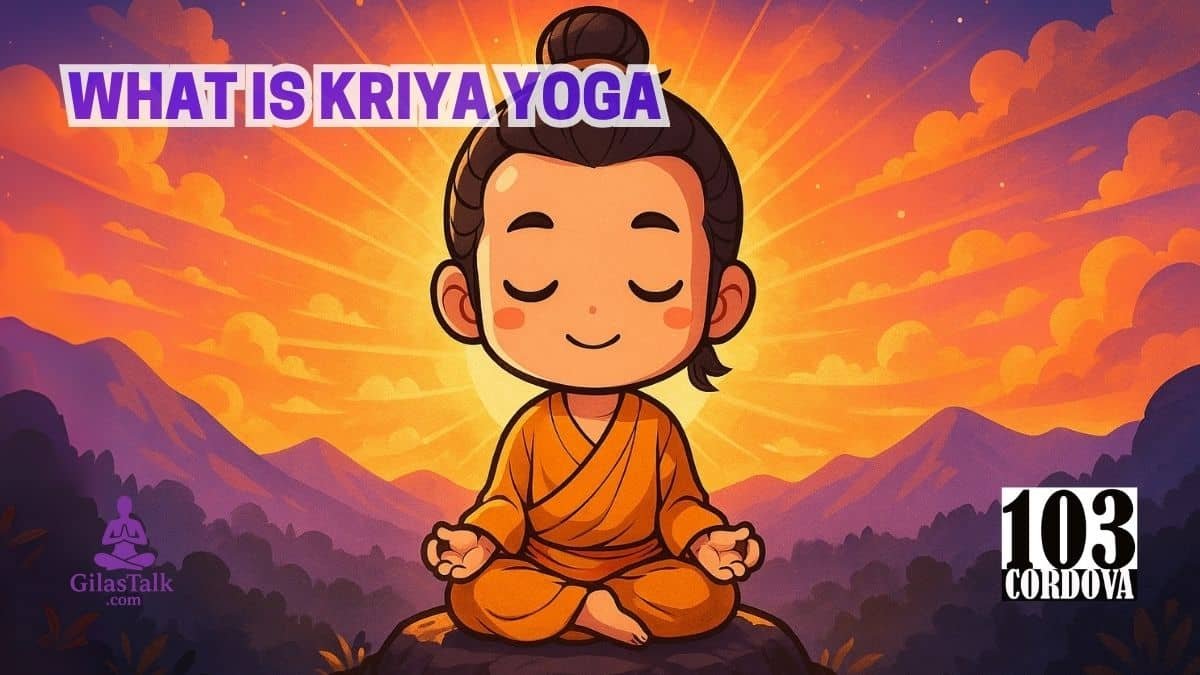Kriya yoga is a spiritual path that focuses on breath and energy control as a way to calm the mind and deepen awareness.
When people ask “What is Kriya yoga?” they often find that it differs from many popular yoga styles that highlight physical postures.
Instead, it emphasizes meditation, inner focus, and disciplined breathing practices that guide a person toward self-realization.
The teachings come from ancient India and were brought to wider attention in the modern world through the work of great teachers.
Today, Kriya yoga is practiced by people who seek not only peace of mind but also a direct experience of spiritual growth.
1. The Historical Roots of Kriya Yoga: A Journey Through Time
Kriya yoga has deep historical roots in the ancient yogic traditions of India, where its teachings were carefully passed down through a lineage of gurus.
This path of Kriya yoga was considered sacred, with the knowledge being shared only with students who had undergone proper initiation and demonstrated readiness for the teachings.
Its techniques, focused on breath control and inner awareness, were practiced by great yogis and saints for centuries as a method to achieve spiritual enlightenment.
The practice of Kriya was often kept secret, reserved for those dedicated to deep spiritual growth and transformation.
It gained wider recognition in the West when Paramahansa Yogananda introduced it in the early 20th century through his influential book Autobiography of a Yogi.
This moment marked a significant expansion of Kriya yoga’s reach, bringing its teachings to a global audience.
Today, the practice of Kriya continues to inspire modern practitioners, offering a disciplined path toward self-realization and inner peace.
🧘 How to Choose Between Vinyasa Vs Yin Yoga for Your Fitness Goals
2. Lineages and Initiation in Kriya Yoga
Kriya yoga is passed from teacher to student through a process called initiation, which means the student learns the practice directly from an experienced guide.
The practice of Kriya Yoga has been preserved through different lineages, with each tracing its teachings back to Lahiri Mahasaya, who is regarded as one of the key figures in its modern revival.
Some lineages, like those associated with Paramahansa Yogananda, place strong emphasis on meditation and devotion, while others may highlight specific breathing techniques.
This variety shows that kriya practice can differ in sequence, number of techniques, or the use of mantras, yet the goal of spiritual growth remains the same.
Because these teachings are considered sacred, initiation acts as a safeguard, ensuring that students are prepared to use the methods with care and discipline.
It also helps the student build a connection with the teacher, which is seen as important for proper guidance and progress.
For those interested in learning, it is wise to approach trusted organizations or teachers within recognized lineages to receive authentic instruction in the practice of Kriya Yoga.
🧘 Hot Yoga Vs Regular Yoga: Which One is Right for You?
3. Core Principles of Kriya Yoga: Understanding the Foundation
The core principles of Kriya yoga center on mastering the flow of energy within the body, with a focus on breath control as a primary tool.
A dedicated disciple of Kriya yoga is taught to consciously direct this energy, calming the mind and accessing deeper states of awareness.
The practice requires discipline and patience, with regular meditation and steady breathing seen as essential for anyone who wishes to grow in this spiritual practice.
Kriya yoga also highlights the importance of ethical living, encouraging purity of thought, kindness in action, and mindfulness in daily life.
Ancient texts such as the Bhagavad Gita remind practitioners of the value of self-mastery, while the yoga sutras of Patanjali provide a broader framework that connects personal conduct, meditation, and inner transformation.
Together, these teachings show that Kriya yoga does not stand apart from tradition but is part of the long history of yogic wisdom.
The principles aim to harmonize the practitioner’s body, mind, and spirit, helping create balance in both inner and outer life.
By applying these foundations, the kriya yogi learns to move beyond distractions and focus on the deeper purpose of life.
For the committed student, Kriya yoga offers a clear path to transcend the ego and awaken to a direct experience of the higher self.
🧘 Ashtanga Yoga Vs. Vinyasa Yoga: Key Differences and Benefits Explained
4. Techniques of Kriya Yoga: Pranayama, Meditation, and More
The core yoga techniques in Kriya yoga include Pranayama, meditation, and deep concentration, all aimed at mastering the life force energy, or prana.
Through controlled breathing in Pranayama, kriya yogis are able to direct this energy throughout the body, clearing blockages and ensuring a free flow of vital energy.
These techniques are deeply spiritual, rooted in ancient wisdom as described by Krishna in texts like the Bhagavad Gita, where inner mastery and connection to the cosmic force are emphasized.
Meditation plays a central role, helping practitioners quiet the mind and develop profound self-awareness, allowing them to perceive their connection to the greater cosmic energy.
In addition to these practices, mantras and visualization are employed to focus the mind and align with the flow of universal consciousness.
These yoga techniques work synergistically to elevate practitioners’ consciousness, allowing them to tap into the cosmic energies that govern life.
Ultimately, these methods lead the practitioner to spiritual insight and a deeper understanding of their place in the cosmic order.
🧘 Why Chair Yoga Training Is Essential for Office Workers

5. The Benefits of Kriya Yoga: Enhancing Mind, Body, and Spirit
Kriya yoga offers numerous benefits that support the well-being of the mind, body, and spirit.
On a physical level, its breathing techniques improve oxygen flow, which helps reduce stress and increase energy.
Mentally, regular practice promotes focus, emotional balance, and a calm state of mind, helping individuals deal with anxiety and negative thoughts.
Spiritually, Kriya yoga fosters a deeper connection to the inner self, allowing practitioners to feel more grounded and aware of their spiritual nature.
These combined benefits make it a holistic practice that enhances overall life quality.
🧘 Why Somatic Yoga Training is a Game Changer for Stress Relief
6. Kriya Yoga vs. Hatha Yoga: Key Differences Explained
Kriya yoga and Hatha Yoga differ primarily in their approach and focus.
Kriya yoga emphasizes breath control and meditation techniques to promote spiritual awakening and higher states of consciousness.
In contrast, Hatha Yoga focuses on physical postures, or asanas, designed to improve strength, flexibility, and balance in the body.
While Hatha Yoga is often more physically oriented, Kriya yoga directs attention inward, working with subtle energies to calm the mind and spirit.
These distinctions reflect each practice’s unique goals, with Kriya yoga being more spiritually focused and Hatha Yoga targeting physical health.
🧘 Can Heated Vinyasa Yoga Help You Lose Weight Effectively?
7. Kriya Yoga vs. Vinyasa Yoga: A Comparative Analysis
Vinyasa Yoga, characterized by fluid movements linked with breath, is a physically dynamic practice, while Kriya yoga is more meditative and inward-focused.
Vinyasa Yoga builds physical endurance, flexibility, and cardiovascular strength through a continuous flow of postures.
Kriya yoga, on the other hand, concentrates on breath regulation and inner stillness to enhance spiritual awareness and mental calm.
The two practices contrast in their goals: Vinyasa seeks physical vitality, while Kriya focuses on spiritual growth and self-realization.
Both practices can complement each other, providing a balance of physical and spiritual benefits.
🧘 How to Learn Aerial Yoga Poses Names for a Better Practice
8. The Spiritual Dimension of Kriya Yoga: Seeking Self-Realization
The spiritual dimension of Kriya yoga is its most defining aspect, with self-realization as its ultimate goal.
Through disciplined practice, practitioners aim to transcend the ego and experience a direct connection with their higher self or divine consciousness.
The techniques of Kriya yoga help quiet the mind and dissolve mental distractions, allowing for deeper meditation and spiritual insight.
As individuals progress, they experience a heightened sense of unity with the universe and the divine, which leads to profound inner peace.
This pursuit of spiritual awakening sets Kriya yoga apart from many other yoga practices that are more physically oriented.
🧘 Exploring the Benefits of Meditation and Yoga
9. Who Can Practice Kriya Yoga? Accessibility for All Levels
Kriya yoga is accessible to individuals of all ages and levels of experience, as it emphasizes meditation and breathwork rather than physical prowess.
Beginners can easily start with basic breathing exercises and gradually deepen their practice.
It does not require the flexibility or strength often associated with other yoga styles, making it approachable for people with varying physical abilities.
The focus on internal processes rather than external postures allows practitioners of all backgrounds to benefit from its techniques.
With dedication and patience, anyone can practice and experience the transformative effects of Kriya yoga.
🧘 Surprising Benefits of Yoga for Health You Need to Know
10. Kriya Yoga in Daily Life: Integrating the Practice
Kriya yoga can be seamlessly integrated into daily life, offering practical tools to improve mental and emotional well-being.
Simple techniques like conscious breathing and short meditation sessions can help manage stress and enhance focus throughout the day.
By incorporating Kriya principles into everyday routines, individuals can maintain a sense of calm and mindfulness, even in challenging situations.
This practice encourages living with greater awareness and clarity, promoting a balanced lifestyle.
Regular engagement with Kriya yoga fosters ongoing personal growth and a deeper connection to one’s spiritual path.
🧘 How the Benefits of Daily Yoga Can Transform Your Life
11. Getting Started with Kriya Yoga: Tips and Resources for Beginners
For beginners interested in Kriya yoga, finding a qualified teacher or enrolling in a certified program is essential for proper guidance.
Reading foundational texts like Paramahansa Yogananda’s Autobiography of a Yogi can also provide valuable insights into the practice.
Many online courses and meditation centers offer structured lessons to help beginners build their skills.
To establish a consistent routine, start with simple breathing exercises and brief meditation sessions.
Consistent practice and patience are key for beginners seeking to fully engage with Kriya yoga’s spiritual benefits.
💡 Conclusion
Kriya yoga occupies a unique position in the broader world of yoga due to its deep spiritual focus and emphasis on breath control and meditation.
Kriya yoga aims to nurture the mind and spirit, guiding practitioners toward self-realization, while other yoga styles may prioritize physical fitness.
Its techniques complement other forms of yoga, offering a more inward path alongside more physically demanding practices.
Kriya yoga’s holistic approach enhances overall well-being by integrating mental clarity, emotional balance, and spiritual growth.
This practice continues to inspire those seeking a profound and transformative yoga experience.
🤝 Our Friends’ Services
Join our Yoga classes for all ages at 103 Cordova Tower, Marquinton Residences, Cirma Street, Sto. Nino, Marikina City.
Whether you’re a beginner or an experienced yogi, our sessions aim to foster physical well-being and inner peace.
We offer a welcoming and supportive environment for people of all fitness levels.
To learn more or book a class, contact us at 09176225780, through Facebook, or via our site’s contact form.
Start your journey to a healthier and more balanced life with us today!
❓ FAQs
1. Is Kriya Yoga the same as other yoga styles like Hatha or Vinyasa?
No.
Kriya Yoga is different because it focuses on meditation, breathing, and energy control instead of physical postures.
Hatha and Vinyasa Yoga are more centered on body movements and strength, while Kriya Yoga directs attention inward toward spiritual growth.
2. Do I need special physical abilities to practice Kriya Yoga?
No.
Kriya Yoga does not depend on flexibility or strength.
It is based on breathing and meditation, so people of all ages and physical conditions can practice it.
3. Why is initiation important in Kriya Yoga?
Initiation means learning directly from a teacher who is trained in the practice.
It helps ensure that the techniques are taught correctly and safely.
This tradition also protects the depth and purpose of Kriya Yoga, which is often kept private until the student is ready.
4. What are the main benefits of Kriya Yoga?
Kriya Yoga helps calm the mind, reduce stress, and improve focus.
It also strengthens emotional balance and supports spiritual growth by connecting practitioners with their inner selves.
With steady practice, people often feel more peace and clarity in daily life.
5. How can I start learning Kriya Yoga?
A good way to begin is by reading trusted books like Autobiography of a Yogi by Paramahansa Yogananda.
Many meditation centers and online programs offer lessons, but it is best to learn from a qualified teacher.
Beginners can also start with simple breathing exercises and short periods of meditation to prepare for deeper practice.

